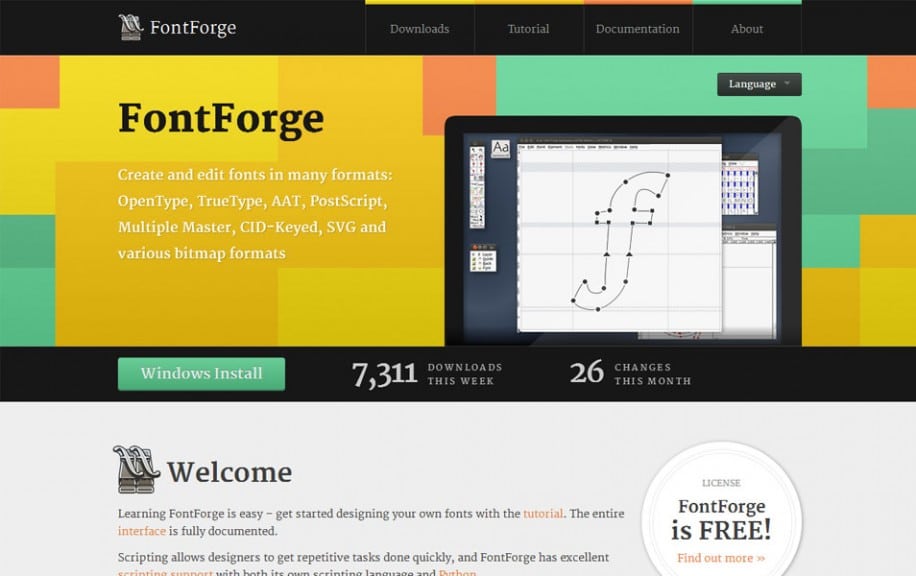

- #FONTFORGE BASELINE HOW TO#
- #FONTFORGE BASELINE FULL#
- #FONTFORGE BASELINE CODE#
- #FONTFORGE BASELINE LICENSE#
As of early 2005, around 10,000 OpenType fonts had become available, with the Adobe library comprising about a third of the total. Adobe finished converting their entire font library to OpenType toward the end of 2002. īy 2001 hundreds of OpenType fonts were on the market. It is a free, publicly available standard. The second edition of the Open Font Format was published in 2009 (ISO/IEC 14496-22:2009) and it is declared as "technically equivalent" to the "OpenType font format specification". The standard is technically equivalent to OpenType 1.4 specification, with appropriate language changes for ISO. It is also sometimes referred to as "Open Font Format Specification" (OFFS). Adoption of the new standard reached formal approval in March 2007 as ISO Standard ISO/IEC 14496-22 (MPEG-4 Part 22) called Open Font Format (OFF, not to be confused with Web Open Font Format). Then, in late 2005, OpenType began migrating to an open standard under the International Organization for Standardization (ISO) within the MPEG group, which had previously (in 2003) adopted OpenType 1.4 by reference for MPEG-4. Open Font FormatĪdobe and Microsoft continued to develop and refine OpenType over the next decade. The name OpenType was chosen for the combined technologies, and the technology was announced later that year. Needing a more expressive font format to handle fine typography and the complex behavior of many of the world's writing systems, the two companies combined the underlying technologies of both formats and added new extensions intended to address those formats' limitations. These efforts were intended by Microsoft and Adobe to supersede both Apple's TrueType and Adobe's Type 1 (" PostScript") font formats. Adobe joined Microsoft in those efforts in 1996, adding support for the glyph outline technology used in its Type 1 fonts. Those negotiations failed, motivating Microsoft to forge ahead with its own technology, dubbed "TrueType Open" in 1994.
#FONTFORGE BASELINE LICENSE#
OpenType's origins date to Microsoft's attempt to license Apple's advanced typography technology GX Typography in the early 1990s. The specification continues to be developed actively and is migrating to an open format.īecause of wide availability and typographic flexibility, including provisions for handling the diverse behaviors of all the world's writing systems, OpenType fonts are used commonly today on the major computer platforms. The specification germinated at Microsoft, with Adobe Systems also contributing by the time of the public announcement in 1996. OpenType is a registered trademark of Microsoft Corporation. It was built on its predecessor TrueType, retaining TrueType's basic structure and adding many intricate data structures for prescribing typographic behavior.
#FONTFORGE BASELINE HOW TO#
This examples shows how to update your label with new text.įont=terminalio.FONT, text="Time Is:\n".format(time.OpenType is a format for scalable computer fonts.
#FONTFORGE BASELINE CODE#
Use File→Generate Font to save the reduced version of the fileĬopy Code # SPDX-FileCopyrightText: 2021 Tim C, written for Adafruit Industries.


(You'll have to re-load your original font file to undo this step)
#FONTFORGE BASELINE FULL#
If you scroll through the full list of glyphs, you'll see there's extra special characters – A whole bunch of them! If you don't need them in your project, just select "space" (the glyph just before "!") plus the basic set of upper/lower and alphanumeric characters. In cases where you need to save on every byte, you can optimize the file size of your fonts by selecting only the characters you want to use. bdf, it's roughly around 900K – That can be a bit larger than needed, especially if you plan to store a lot of image and sound assets. If you take a look at the file size of the.


 0 kommentar(er)
0 kommentar(er)
